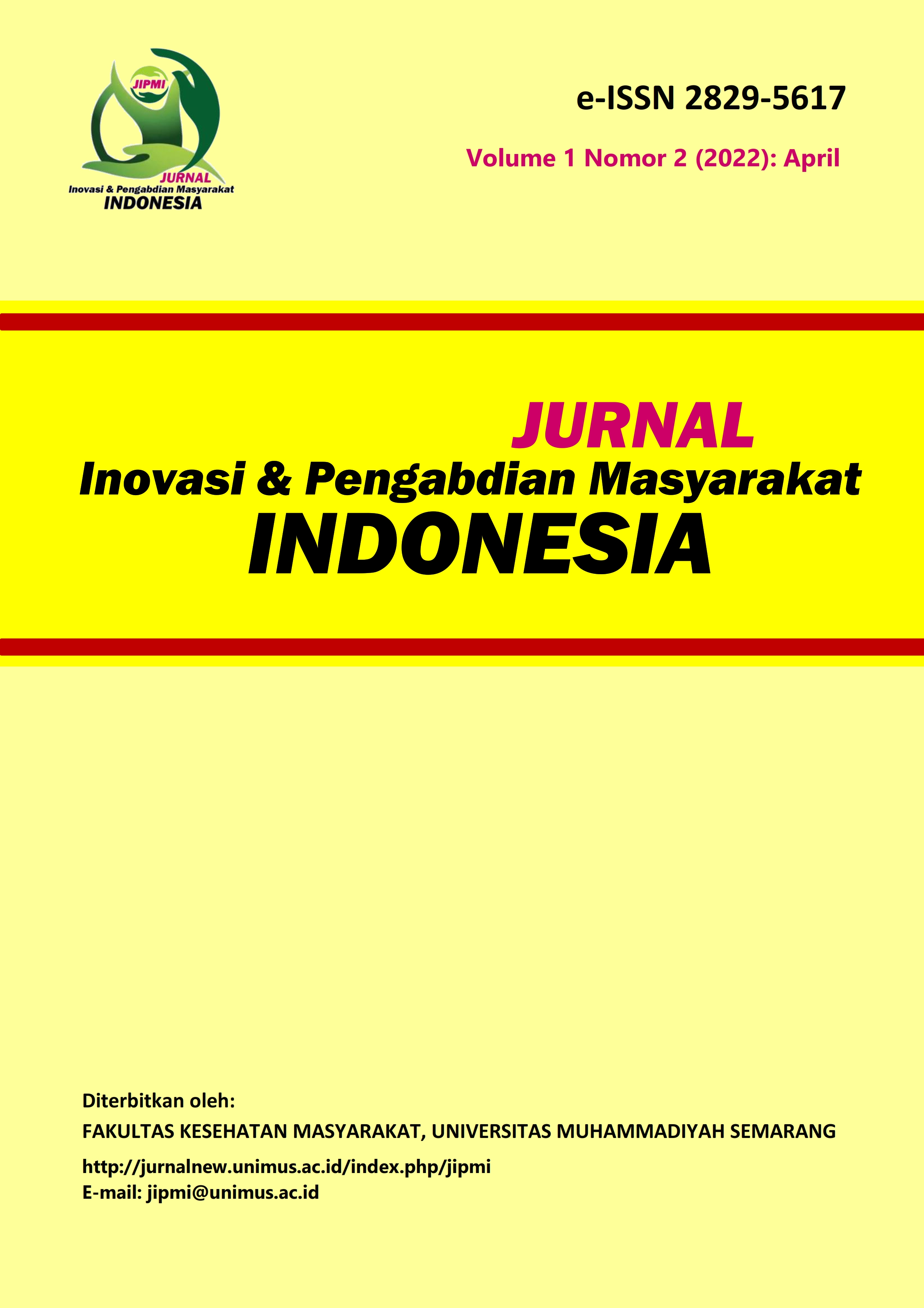Edukasi Bahaya Asap Rokok Melalui Komik ASETARO Di SD N Jembrak Kecamatan Pabelan Kabupaten Semarang
DOI:
https://doi.org/10.26714/jipmi.v1i2.6Kata Kunci:
Edukasi kesehatan, Bahaya asap rokok, Komik ASETAROAbstrak
Latar belakang: Perlindungan terhadap anak-anak dari bahaya merokok penting untuk dilakukan, karena anak-anak berpeluang untuk menjadi perokok aktif dan pasif. Tidak hanya di perkotaan, anak-anak di pedesaan juga memiliki peluang yang sama untuk terkena penyakit akibat rokok. Analisis situasi di SD N Jembrak Kecamatan Pabelan Kabupaten Semarang menunjukkan bahwa para siswa membutuhkan informasi tentang bahaya asap rokok bagi kesehatan mereka. Tujuan: para siswa mengetahui bahaya asap rokok bagi kesehatan, sehingga dapat melindungi dari dari bahaya asap rokok. Metode: Edukasi kesehatan menggunakan media komik ASETARO, yang diawali dengan pre-test dan diakhiri dengan pos-test dan tanya jawab. Pre-test dan post-test digunakan untuk evaluasi hasil edukasi. Hasil: Para siswa menyukai edukasi melalui komik ASETARO karena mereka memperoleh informasi secara menyenangkan melalui gambar-gambar yang menarik dan mudah dipahami. Pada hasil pre-test hanya 8% siswa yang memperoleh nilai pengetahuan dalam kategori baik, namun pada hasil post-test telah meningkat menjadi 83%. Hal ini menunjukkan bahwa setelah memperoleh informasi tentang bahaya asap rokok melalui komik ASETARO pengetahuan siswa mengalami peningkatan. Kesimpulan: Kegiatan pengabdian masyarakat menggunakan media komik ASETARO pada siswa di SDN Jembrak Kecamatan Pabelan Kabupaten Semarang mengenai bahaya asap rokok dapat meningkatkan pengetahuan sasaran.
Kata kunci: Edukasi kesehatan, bahaya asap rokok, komik ASETARO
__________________________________________________________________________________________
Abstract
Background: It is important to protect children from the harm of smoking because children have the opportunity to become active and passive smokers. Not only in urban areas, but children in rural areas also have the same opportunity to get diseases caused by smoking. Analysis of the situation at SD N Jembrak, Pabelan District, Semarang Regency, showed that students needed information about the harmful of cigarette smoke on their health. Objective: students know the harm of cigarette smoke to health, so they can protect themselves from the harm of cigarette smoke. Method: Health Education using ASETARO Comic media, which begins with a pre-test and ends with a post-test and question and answer. Pre-test and Post-test are used to evaluate educational outcomes. Result: The students liked education through ASETARO comics because they got information in a fun way through interesting and easy-to-understand. In the pre-test results, only 8% of students obtained knowledge scores in the good category, but the post-test results increased to 83%. This shows that after obtaining information about the harmful of cigarette smoke through ASETARO Comics, students' knowledge has increased. Conclusion: Community service activities using ASETARO Comics media to students at SDN Jembrak, Pabelan District, Semarang Regency about the harmful of cigarette smoke can increase children's knowledge.
Keywords: Health education, the harmful of cigarette smoke, ASETARO comics
Referensi
D. R. Ariani, S. Mulyono, and Widyatuti, “Risk Factors for the Initiation of Smoking Behavior in Primary School Age Children in Karawang, Indonesia,” Compr. Child Adolesc. Nurs., vol. 42, no. sup1, pp. 154–165, 2019, doi: 10.1080/24694193.2019.1578436.
J. Leonardi-Bee, M. L. Jere, and J. Britton, “Exposure to parental and sibling smoking and the risk of smoking uptake in childhood and adolescence: A systematic review and meta-analysis,” Thorax, vol. 66, no. 10, pp. 847–855, 2011, doi: 10.1136/thx.2010.153379.
C. T. Leshargie et al., “The impact of peer pressure on cigarette smoking among high school and university students in Ethiopia: A systemic review and meta-analysis,” PLoS One, vol. 14, no. 10, pp. 1–19, 2019, doi: 10.1371/journal.pone.0222572.
M. Bigwanto, A. Mongkolcharti, K. Peltzer, and O. Laosee, “Determinants of cigarette smoking among school adolescents on the island of Java, Indonesia,” Int. J. Adolesc. Med. Health, vol. 2015, 2015, doi: 10.1515/ijamh-2015-0036.
Kemenkes RI, “Riskesdas 2013,” 2013. doi: 10.22201/fq.18708404e.2004.3.66178.
Kemenkes RI, “Laporan Survei Indikator Kesehatan Nasional 2016 (Report of National Health Indicators Survey 2016),” no. November 2016, 2016.
Kemenkes RI, “Riskesdas 2018,” Badan Penelitian dan Pengembangan Kesehatan. p. 198, 2018.
K. Gibbs, J. M. Collaco, and S. A. McGrath-Morrow, “Impact of tobacco smoke and nicotine exposure on lung development,” Chest, vol. 149, no. 2, pp. 552–561, 2016, doi: 10.1378/chest.15-1858.
L. A. Peterson and S. S. Hecht, “Tobacco, E-Cigarettes and Child Health,” Physiol. Behav., vol. 29, no. 2, pp. 225–230, 2017, doi: 10.1097/MOP.0000000000000456.Tobacco.
G. Raghuveer et al., Cardiovascular Consequences of Childhood Second hand Tobacco Smoke Exposure, vol. 134, no. 16. 2016.
H. B. Saputro and Soeharto, “Pengembangan Media Komik Berbasis Pendidikan Karakter pada Pembelajaran Tematik-Integratif Kelas IV SD,” J. Prima Edukasia, vol. 3, no. 1, pp. 61–71, 2015.
A. Mendelson et al., “Comics as an educational tool for children with juvenile idiopathic arthritis,” Pediatr. Rheumatol., vol. 15, no. 1, pp. 1–6, 2017, doi: 10.1186/s12969-017-0198-5.
P. Branscum, M. Sharma, L. Leigh Wang, B. R. A. Wilson, and L. Rojas-Guyler, “A true challenge for any superhero: An evaluation of a comic book obesity prevention program,” Fam. Community Heal., vol. 36, no. 1, pp. 63–76, 2013, doi: 10.1097/FCH.0b013e31826d7607.
T. Salawati and N. Indrawati, “Analisis Kebutuhan untuk Merancang Komik Anak ‘ASETARO’ (Aku Akan Tetap Sehat Tanpa Asap Rokok),” J. Kesehat. Masy., vol. 11, no. 2, pp. 96–105, 2016, doi: http://dx.doi.org/10.15294/ kemas.v11i1.3521.
John Hopkins University, The P Process, Five Steps to Strategic Communication. Johns Hopkins Bloomberg School of Public Health Center for Communication Programs., 2013.
K. Hamida, S. Zulaekah, and Mutalazimah, “Penyuluhan Gizi dengan Media Komik Untuk Meningkatkan Pengetahuan Tentang Keamanan Makanan Jajanan,” J. Kesehat. Masy., vol. 8, no. 2, pp. 113–120, 2013, doi: ISSN 1858-1196.
Unduhan
Diterbitkan
Cara Mengutip
Terbitan
Bagian
Lisensi
Hak Cipta (c) 2022 Jurnal Inovasi dan Pengabdian Masyarakat Indonesia

Artikel ini berlisensiCreative Commons Attribution-ShareAlike 4.0 International License.
















